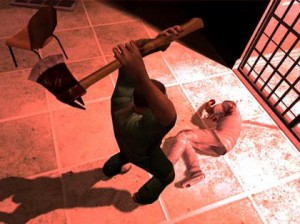It seems that governments and parents regularly become fixated on the content of games. They talk about gaming as though it is the corrupter of youth, the new source of society`s ills. Television and cinema are probably laughing themselves to sleep after being the target of similar complaints for the last thirty years because the news media has finally found a new target.
It is an easy way to score points for politicians: target the gaming industry as it is starting to establish itself and blame it for a social problem to distract the voting populous from real issues. It isn’t only politicians, as lawyers defending young clients grasp for evidence to support their plea of diminished responsibility also find gaming a convenient scapegoat.

But let us take a step back from this. At school both boys` behavior had been noted as attention seeking. One was also reported to have acted hysterically, displaying an immense amount of hostility and denial of his abusive home life, while the other allegedly was in the grip of a controlling and demanding family. Neither had ideal home lives and it appears both were exposed to adult movies with no adult influence in their lives to put what they were seeing into any kind of context. Thus while perhaps the movie provided a stimulation, or even a catalyst to the boys action, in isolation it was far from the root cause.
Many children just do not have the counterbalance of thoughtful parents to help them manage their own aggression.
Let us assume for a moment that games, movies, and television actually do lead children to violence. Gaming has time and time again proven to be far ahead of other media in its self-policing of content by producing its [not it’s] own ratings system and by approaching the BBFC film classifications board to provide a legally enforceable classification when this was felt to be insufficient (in the UK at least). Combined with the fact that game stores have been proven the most vigilant of all media outlets in their distribution of products to minors and it makes you wonder why gaming is currently the press` entertainment target of choice.

The same can now be said of games. Parents see these games and assume they are all Mario or Pac-man. As with anime, they neglect to educate themselves on the content or heed warnings from regulating bodies. They buy games for their children and the ones who are unbalanced or who lack the support of a loving family see the games and use them as a point of departure, or inspiration, for preexisting violent tendencies. Then those parents who were unaware of their offspring’s volatile nature look for something to blame other than their own shortcomings or imbalances in their children’s mental health.
When we talk about the media we expose our children to it is always the big stuff, children who are exposed to entertainment that is not explicitly for them. We neglect the smaller things that are supposedly aimed at a younger audience. We overlook the age at which our children are exposed to violence as a solution to problems. Many cartoons rely on this. In a world where conflict is everywhere resolution has to be taught and the most understandable, visually exciting, and direct method is a physical confrontation. I watched He-Man from an incredibly young age. No one gave it a second thought but he never sat down and worked out his differences with Skeletor. He never tried to find a common ground. I probably wouldn’t have watched if he had.
The life’s work is to learn that most things, and most of us, are a mixture of both, and a full-blooded relationship means coping with the good and bad. Babies are full of aggression, which they need to make them feel powerful in the face of terrible anxieties: if they are not helped with the aggression by parents who can think about their worries and decontaminate them a bit, or by parents who augment it by being aggressive in return, or by being so frightened of it that their fear is fed back to the baby, then they are very vulnerable.
The Japanese kindergarteners I teach all watch Anpanman. He is a talking flying bread roll, initially conceived to entice kids to eat bread. My students run around hitting each other (and me) yelling “Anpan-PUNCH”, because that how nearly every episode concludes and how all the show`s problems are resolved. Yes, he is fighting to uphold morally righteous goals, but children often believe they are morally right in their actions. I can think of very few games designed for an audience of a similar age that teaches the same lessons. For the most part titles explicitly aimed at a preschool audience are learning tools.

People assimilate everything they see in some fashion. Children do so even more than others as they lack the filters of more mature (psychologically balanced) individuals. It is the context and teaching around the actions that are assimilated that makes the difference. The responsibility of this lies with parents, families and (to a lesser extent) teachers and the community they are raised in. As long as industries supply the basic tools for everyone to make informed decisions, and parents are vigilant of their children’s media consumption then there is no entertainment that is any more harmful than another. It is tempting for all however in the wake of some current events to look for someone else to blame, because the alternative is to say that families and society are failing these children in need of help.
We happily transport our own less comfortable feelings into another and then attack them – that is the basis of racism and bullying – we project our feelings of fear and tininess into the fat kid in the corner and then have a go at him.
All quotes from Suzanne G Beech – Child Psychotherapist.